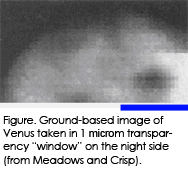
The discovery of spectral “windows” in the near IR spectrum of Venus, through which thermal radiation from the hot lower atmosphere and even the surface can leak to space, provides a powerful tool to study the atmosphere below the clouds. Since these emissions are much weaker than the solar radiation, they can be observed only on the night side of the planet. Emission around 1 µm “window” which is covered by the VMC near-IR filters originates at the surface. Its intensity depends on the surface temperature and thus elevation, total cloud opacity, water column density and to a smaller extent on the surface emissivity and water vapour vertical distribution.
The VMC near-IR filters have the following specific tasks in the night side sounding. NIR1 channel is centered at the H2O band at 965 nm and will focus on the study of water spatial distribution in the lower 10 km. The NIR2 channel (1000 nm) will perform thermal imaging of the surface and monitor the variability of the cloud optical depth and atmospheric dynamics by tracking the motions of the near-IR cloud features. Also the imaging in the NIR2 filter will used to search for traces of volcanic activity like hot lava outflows. It should be mentioned that the spatial resolution of VMC surface observations will be limited by the scattering in the clouds and will not exceed 50 km. Global thermal imaging of the Venus surface will be performed for the first time and will significantly complement the Magellan radar investigations.
The NIR2 channel covers the spectral range which is free from gaseous absorption. For this reason its measurements are not sensitive to the water vapour abundance. Intensity in this channel mainly depends on the surface temperature. Thus spatial variations of the measured brightness are expected to be correlated with the topography. Surface elevations of ~10 km result in temperature contrasts up to 80 C that would be clearly visible in the images. Since previous in-situ measurements indicated constant temperature structure of the lower atmosphere, the VMC measurements can be used either to study the surface emissivity and constrain the composition or to derive the vertical temperature profile in the lower scale height under the assumption that in a very dense atmosphere the surface temperature is equal to that of the atmosphere. Also the imaging in the NIR2 filter will used to search for traces of volcanic activity like hot lava outflows. It should be mentioned that the spatial resolution of VMC surface observations will be limited by the scattering in the clouds and will not exceed 50 km. Global thermal imaging of the Venus surface will be performed for the first time and will significantly complement the Magellan radar investigations.
